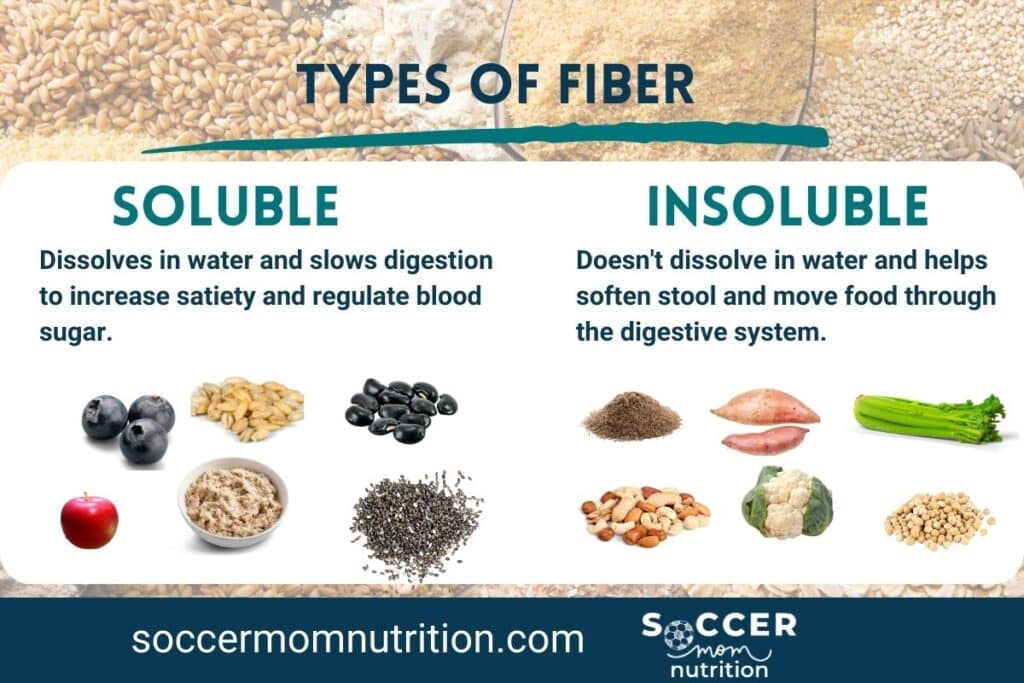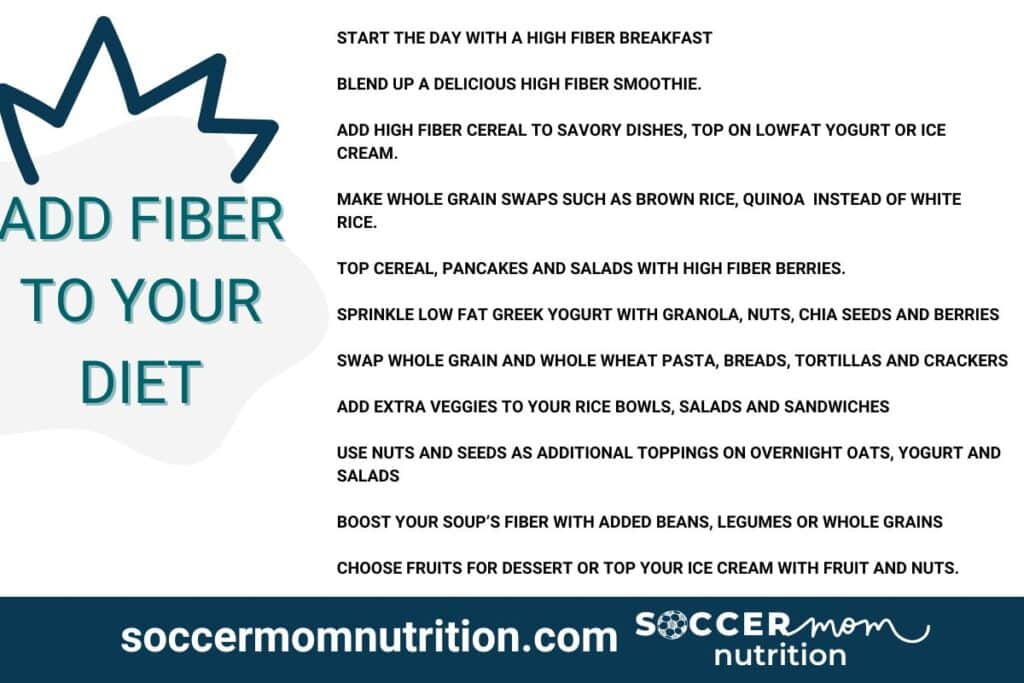Importance of Fiber for Athletes: Why Athletes Need More Fiber
If you’re an athlete or someone who loves to exercise, you understand the importance of eating well and fueling your body. But here’s something you might not have considered: the importance of fiber for athletes.
Yes, fiber – that humble carbohydrate your body can’t digest – plays a significant role in optimizing athletic performance and overall health.
In this post, I’ll share its benefits and how to incorporate it into your healthy athlete diet with high fiber cereals, fruits and vegetables and other foods.

What is fiber?
Fiber is a type of carbohydrate that your body cannot digest. It is found in plant foods such as fruits, vegetables, grains, nuts, seeds, and legumes. Fiber is the part of plant foods that your body cannot break down or absorb.
It passes through your digestive system mostly unchanged, adding bulk to your stool and helping you stay regular. There are two main types of fiber: soluble and insoluble.
Soluble fiber
Soluble fiber dissolves in water and forms a gel-like substance in your intestines. It helps you feel full longer, which can help you control your appetite and weight.
Some examples of foods that contain soluble fiber are oats, barley, beans, lentils, apples, pears, citrus fruits, and psyllium.
Soluble fiber can also help lower your blood cholesterol and glucose levels, which can reduce your risk of heart disease and diabetes.
Insoluble fiber
Insoluble fiber does not dissolve in water and passes through your digestive system mostly intact (meaning it doesn’t really break down). It helps add bulk to your stool and prevents constipation.
Some examples of foods that contain insoluble fiber are whole wheat, bran, brown rice, quinoa, nuts, seeds, carrots, celery, and broccoli.

Benefits of fiber for athletes
Fiber has many benefits for athletes, both for performance and health.
Here are some of the main benefits of fiber for athletes:
Steady energy
High fiber foods help keep your energy levels stable throughout the day. Fiber slows down how your body digests carbs, helping to avoid sudden spikes and drops in blood sugar.
This consistent energy is key for staying active and not running out of steam mid-workout or game.
Digestive health
Fiber is fantastic for your digestive system. It helps keep things moving smoothly in your gut, which is essential for athletes who need their bodies to perform well.
A healthy gut means better digestion and a lower chance of feeling bloated or uncomfortable during exercise.
Plus, a well-functioning digestive system supports a strong immune system and can help lower inflammation in the body, which is beneficial for muscle and joint health.
Weight management
For those trying to maintain a healthy body composition, high fiber foods can be helpful. They make you feel fuller for longer, cutting down on unnecessary snacking and helping control calorie intake.
Nutrient rich
People who eat high fiber foods tend to get more vitamins and minerals in their diet. These nutrients are crucial for overall health and help your body function optimally.
Fiber also plays a role in bone health by helping your body absorb calcium more effectively.
Gut bacteria and performance
Emerging research suggests that a diverse gut microbiome, supported by a fiber-rich diet, might improve athletic performance.
A varied population of gut bacteria can help reduce inflammation, potentially speeding up recovery times and enhancing performance.
Requirements of fiber for athletes
The amount of fiber you need depends on your age, gender, and activity level. The general recommendation for adults is to consume 25 to 38 grams of fiber per day, with at least 10 to 15 grams coming from soluble fiber.
General recommendations for daily fiber intake:
| Age (years) | Fiber Recommendations (grams/day) | |
|---|---|---|
| Men | Women | |
| 4-8 | 25 g | 25 g |
| 9-13 | 31 g | 26 g |
| 14-18 | 38 g | 26 g |
| 19-30 | 38 g | 25 g |
| 31-50 | 38 g | 25 g |
| 51-70 | 21 g | 30 g |
However, athletes may need more fiber than the average person, especially if they have a high-calorie intake or a high-carb diet. Athletes may need to aim for the upper limit of fiber intake.
It’s also important to note that too much fiber can also have negative effects, such as gas, bloating, cramping, and diarrhea
So, it is best to increase your fiber intake gradually and drink plenty of water to avoid these problems.
You should also avoid eating too much fiber before or during exercise, as it can cause gastrointestinal distress and impair your performance.
Adding fiber to your diet
Incorporating fiber-rich foods into your athlete’s diet is essential for meeting your nutritional needs and supporting your performance goals.
Here are some practical tips for increasing fiber intake:
- Start the day with a high fiber breakfast such as high fiber cereal, oatmeal, pancakes made with whole grains, or whole wheat toast with avocado.
- Blend up a delicious high fiber smoothie using ingredients like spinach, berries, banana, and chia seeds.
- Add high fiber cereal to savory dishes, top on lowfat yogurt or ice cream.
- Make whole grain swaps such as brown rice, quinoa instead of white rice.
- Top iron rich cereal, pancakes and salads with high fiber berries.
- Sprinkle low fat greek yogurt with granola, nuts, chia seeds and berries.
- Swap whole grain and whole wheat pasta, breads, tortillas and crackers.
- Add extra veggies to your rice bowls, salads and sandwiches.
- Use nuts and seeds as additional toppings on overnight oats, yogurt and salads.
- Boost your soup’s fiber with added beans, legumes or whole grains.
- Choose fruits for dessert or top your ice cream with fruit and nuts.

High fiber food chart
For a comprehensive list of high-fiber foods to incorporate into your diet, refer to our high fiber food chart post and the free printable.

Final thoughts
Fiber is a key nutrient for athletes, offering numerous benefits such as improved energy levels, digestion, weight management, and overall health.
By incorporating high fiber cereals and other fiber-rich foods into your daily diet, you not only meet your fiber requirements but also unlock the full potential benefits of fiber for athletes.
So, aim to include fiber in every meal and snack, and see how it transforms your well-being and elevates your performance to new heights.
Join our mailing list and get our FREE Pre-Activity Fueling Guide.
Stephanie Magill, MS, RD, CD, FAND has over 22 years of experience in public health and nutrition. As a performance registered dietitian nutritionist, Stephanie specializes in sports nutrition and provides simple and actionable information so that athletes can be well fueled for high performance on and off the field. Stephanie has a Master’s Degree in Nutrition and is a Fellow of the Academy of Nutrition and Dietetics.

